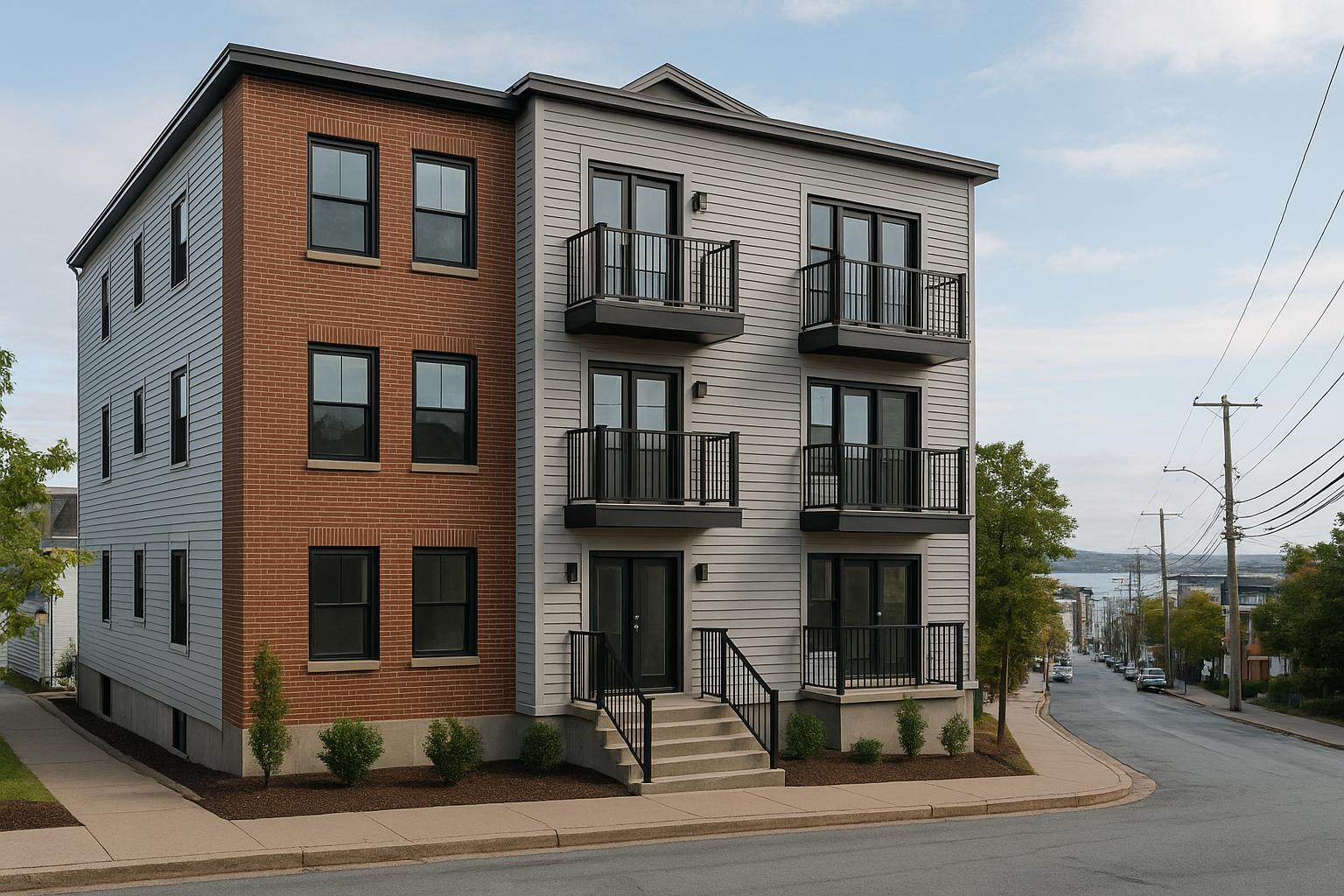Want a storm-resistant coastal home in Nova Scotia? Here's how to build one that lasts.
Nova Scotia's coastal homes face rising sea levels, stronger storms, and harsh maritime conditions. To protect your property, focus on:
- Strong foundations: Elevate homes above flood levels using reinforced materials.
- Salt-resistant materials: Use stainless steel, fibre cement siding, and corrosion-proof roofing.
- Storm protection features: Install hurricane straps, impact-resistant windows, and reinforced roofs.
- Smart site selection: Build at safe elevations, maintain shoreline setbacks, and assess ground stability.
- Regular maintenance: Inspect for salt damage, repair storm damage, and upgrade older homes with modern features.
New rules in the District of Lunenburg require setbacks, elevation above flood levels, and environmental assessments to protect homes and ecosystems. Attend open houses in May and June 2025 to learn more.
Building costs start at $168 per square foot, making storm-proof homes accessible and future-ready.
Coastal Building Challenges in Nova Scotia
Weather Risks and Sea Levels
Coastal areas in Nova Scotia face growing challenges due to climate change. Rising sea levels, storm surges, and high winds are some of the major concerns. Here are a few specific risks:
- Storms: Strong winds can put significant stress on buildings.
- Salt spray: Speeds up the corrosion of materials, especially metals.
- Erosion: Weakens shoreline stability, impacting nearby structures.
Current Building Regulations
The Municipality of the District of Lunenburg (MODL) is introducing updated coastal protection rules that will change how construction is handled in these areas [1]. Key requirements include:
- Mandatory setbacks: New buildings must keep a minimum distance from the shoreline.
- Elevation rules: Structures must be built above predicted flood levels.
- Environmental assessments: Sites need to be evaluated to reduce harm to coastal ecosystems.
- Permits: Special permits are required for building in designated coastal protection zones.
To help property owners understand these changes, MODL is hosting open houses and presentations during May and June 2025 [1]. Next, we’ll look at ways to address these challenges effectively.
A Guide to Buying a Coastal Home in Nova Scotia
Storm-Proof Building Methods
Constructing a durable coastal home in Nova Scotia means using techniques and materials built to handle the region's tough maritime climate. The focus is on solid foundations, materials that resist corrosion, and features designed to protect against storms.
Strong Foundations
To prevent flood damage, elevate homes on reinforced concrete piers or columns above flood levels. Ensure the foundation is deep enough, properly reinforced, and includes efficient drainage systems. Always follow local building codes and adapt designs to the specific site.
Materials That Resist Salt
Coastal homes face constant exposure to salt and moisture, so it’s important to pick the right materials. Use stainless steel fasteners, fibre cement or vinyl siding, and engineered windows. For roofs and decks, choose materials specifically designed to resist corrosion and rot.
Features for Storm Protection
Certain design elements can help your home handle intense storms:
- Hurricane straps: Secure roof trusses to walls for added stability.
- Impact-resistant windows and doors: Protect against high winds and flying debris.
- Reinforced roof systems: Use high-quality construction techniques to ensure roofs can withstand strong winds and impacts.
These strategies provide a solid foundation for building homes that can endure Nova Scotia's coastal challenges.
sbb-itb-16b8a48
Choosing a Coastal Building Site
Selecting the right location for your coastal home is just as important as using sturdy construction methods. A thoughtful site choice helps protect your investment from potential coastal risks. This process involves assessing safety, regulatory requirements, and site-specific factors to turn concerns about coastal hazards into practical decisions.
Land Elevation Requirements
Ensuring your home is built at the right elevation is crucial to guarding against floods and storm surges. When evaluating a site, take into account:
- Local municipal rules on minimum elevation
- The property's natural drainage patterns
- Historical flood records
- Proximity to flood-prone areas
To get accurate elevation data and confirm compliance, work with experienced surveyors. Notably, the Municipality of the District of Lunenburg (MODL) is in the process of creating new coastal protection guidelines that will influence elevation standards [1].
Shoreline Safety Distances
Keeping a safe distance from the shoreline helps secure your property’s foundation over time. Setback rules are currently being reviewed [1]. Important factors to consider include:
- Existing setback regulations
- Patterns of erosion in the area
- Projections for future erosion
- Presence of natural buffer zones
You can stay informed about these updates by attending MODL's Drop-In Open Houses in May and June 2025, where new coastal protection measures will be discussed [1].
Ground Stability Tests
Before construction, it’s essential to conduct detailed ground stability tests. These include:
- Soil composition analysis: To understand the type and stability of soil layers
- Bedrock depth assessment: To determine foundation needs
- Drainage capacity testing: To evaluate water management capabilities
Geotechnical surveys carried out by professionals can uncover potential challenges early on. This is especially important in Nova Scotia, where unique coastal conditions and a changing climate can impact ground stability.
Considering emergency preparedness and the effects of climate change is critical when building in coastal areas like Lunenburg. Your site choice should address both current risks and future projections to ensure your home stays safe and meets regulatory standards for years to come [1].
Long-Term Home Care
Keeping your coastal home in good shape requires regular upkeep to counteract the challenges posed by saltwater exposure and harsh maritime conditions. Staying on top of maintenance ensures your home's durability and ability to withstand storms.
Inspection Schedule
Routine inspections are key to catching problems early. Make sure to:
- Check exterior surfaces for signs of salt damage or corrosion.
- Inspect metal components, such as railings or fixtures, for rust or wear.
- Examine shingles, flashing, and gutters, especially after storms, for damage or debris buildup.
If you spot any issues during inspections, repair them quickly to keep your home storm-ready.
Storm Damage Repairs
After a storm, it’s crucial to assess your home for any structural or functional damage. Focus on areas like:
- The foundation: Look for cracks or signs of shifting.
- Windows and doors: Check seals for water leaks.
- The roof: Inspect for loose or missing shingles and other materials.
- Drainage systems: Ensure they’re working properly to avoid water pooling.
Don’t forget to document any damage for your insurance claims.
Updates for Older Homes
If you own an older coastal home, upgrading certain features can improve its strength and longevity. Some smart updates include:
- Installing impact-resistant windows and doors.
- Adding modern waterproofing systems to prevent leaks.
- Reinforcing the roof with hurricane straps for extra stability.
- Setting up storm shutters or similar protective measures.
When renovating, consider adding features specifically designed to handle severe weather. It’s an investment that can save you money - and stress - in the long run.
Conclusion
Building a durable coastal home in Nova Scotia takes careful planning and modern construction techniques. Following these practices ensures your home can handle the challenges of maritime weather while staying aligned with Nova Scotia's climate initiatives.
The process involves thoughtful site selection, using long-lasting materials, and adhering to regulations. Together, these steps provide a clear path to creating a home that stands the test of time.
Next steps to consider:
- Reach out to Nova Scotia Environment - Climate Change Unit for the latest guidelines.
- Attend local open houses on district property regulations.
- Consult with Efficiency Nova Scotia about energy-saving features for your home.
As regulations evolve with the changing climate, staying informed and proactive is key. By including storm-resistant designs and meeting current standards, you're investing in a home built to last for future generations.
With fixed-price construction starting at $168 per square foot, creating a storm-ready coastal home is within reach. This approach not only meets Nova Scotia's requirements but also ensures peace of mind for your coastal lifestyle.
FAQs
What materials are best for building a hurricane-resistant coastal home in Nova Scotia?
To build a storm-resistant home by the coast in Nova Scotia, it’s essential to use durable materials that can withstand extreme weather and saltwater exposure. Key materials include:
- Raised foundations or piers to prevent flood damage
- Hurricane straps and reinforced roof designs for high winds
- Impact-resistant windows to handle flying debris
- Fibreglass doors and stainless steel fastenings to resist corrosion
- Concrete siding for durability against storms and freeze-thaw cycles
These materials not only enhance your home’s resilience but also help protect your investment and ensure long-term safety in Nova Scotia’s challenging coastal climate.
How do the new building regulations in the District of Lunenburg impact coastal home construction?
The District of Lunenburg’s new building regulations require all new construction in designated coastal areas to comply with measures that reduce environmental impact and minimize risks from hazards like flooding and storm surges. These regulations are part of Nova Scotia’s broader Coastal Protection measures, which aim to address the challenges of climate change and rising sea levels.
If you're planning to build near the coast, you’ll need a special development permit and must adhere to guidelines such as setback distances from the shoreline and elevation requirements. These steps ensure safer, more sustainable coastal development for the long term.
How can I maintain and protect my coastal home in Nova Scotia’s challenging maritime climate?
To keep your coastal home in Nova Scotia durable and safe, regular maintenance is crucial due to the region’s harsh maritime conditions. Saltwater exposure, high winds, and freeze-thaw cycles can accelerate wear on materials, so it’s important to inspect and address issues like corrosion, rot, or weather damage promptly.
Focus on using weather-resistant materials such as stainless steel fastenings, fibreglass doors, and concrete siding to reduce long-term damage. Regularly repaint exterior surfaces, clean salt deposits, and check for damage to windows, roofs, and foundations after storms.
Additionally, implementing storm-resilient features like impact-resistant windows, reinforced roofs, and elevated foundations can protect your home and may even lower insurance premiums. Staying proactive with maintenance ensures your home remains safe, comfortable, and ready to withstand Nova Scotia’s coastal challenges.
Related Blog Posts
- Building on the Nova Scotia Coast: How to Design and Construct Durable Seaside Home
- Common Mistakes to Avoid When Building a Home in Nova Scotia
- Green Building in Nova Scotia: Top 10 Energy-Efficient Features for Your Custom Home
- Designing Your Nova Scotia Coastal Dream Home: Embrace the Ocean, Resist the Elements



